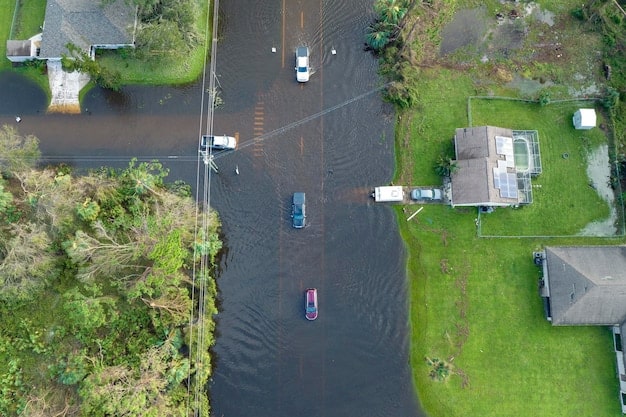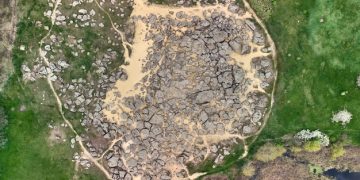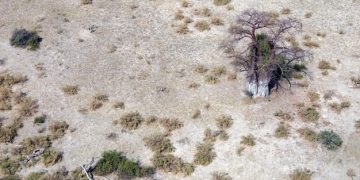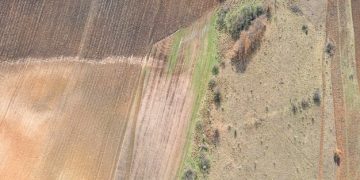US Government Initiatives for Extreme Weather Support

The US government is actively implementing and expanding initiatives focused on preparedness, response, and long-term recovery to support communities increasingly impacted by extreme weather events, aiming for enhanced resilience and adaptation.
As climate patterns shift and extreme weather events become more frequent and severe, the critical question arises: What are the Latest Government Initiatives to Support Communities Affected by Extreme Weather? This query delves into the heart of federal, state, and local efforts aimed at bolstering resilience, facilitating recovery, and safeguarding populations against the escalating impacts of droughts, floods, wildfires, and superstorms.
Enhancing Disaster Preparedness and Mitigation Strategies
The core of effective extreme weather support lies in robust preparedness and mitigation. Governments, at all levels, are increasingly shifting focus from reactive response to proactive planning. This includes investing in infrastructure resilient to future climate shocks and developing early warning systems that can provide communities with crucial lead time.
A significant aspect of these efforts involves updating building codes to withstand stronger winds and heavier snowfalls, especially in regions prone to specific weather events. Federal grants are often made available to states and municipalities to implement these changes, ensuring that new constructions are inherently safer and more durable.
The Role of FEMA’s Building Resilient Infrastructure and Communities (BRIC) Program
The Federal Emergency Management Agency (FEMA) plays a pivotal role. Its Building Resilient Infrastructure and Communities (BRIC) program is a cornerstone of federal mitigation efforts. This program, which replaced the Pre-Disaster Mitigation (PDM) grant program, offers substantial funding to states, local communities, tribes, and territories for hazard mitigation projects. The aim is to reduce risks from natural disasters and hazards.
- Funding Allocation: BRIC prioritizes projects that incorporate nature-based solutions and those that have a clear, measurable reduction in risk.
- Community Engagement: The program encourages community-driven solutions, emphasizing projects that reflect local needs and vulnerabilities.
- Innovation and Efficiency: BRIC seeks to fund innovative projects that can serve as models for resilience nationwide.
Beyond BRIC, other initiatives focus on strengthening critical infrastructure, such as power grids, water treatment facilities, and transportation networks. The devastating impact of recent storms has highlighted vulnerabilities in these systems, prompting a concerted effort to harden them against future disruptions. This involves adopting smart grid technologies, burying power lines in vulnerable areas, and upgrading water management systems to handle extreme precipitation events.
Moreover, natural infrastructure solutions are gaining traction. Restoring wetlands, preserving coastal dunes, and managing forests to prevent wildfires are becoming integral parts of government mitigation strategies. These natural buffers can significantly reduce the impact of extreme weather, often at a lower cost than engineered solutions, while providing ecological benefits.
Streamlining Emergency Response and Recovery Operations
When extreme weather strikes, the efficiency of emergency response and the speed of recovery are paramount. Governments are continually refining their operational frameworks to ensure rapid deployment of resources, effective communication, and timely assistance to affected populations. This involves coordinating efforts across multiple agencies and leveraging advanced technology.
Improved inter-agency coordination is a persistent goal, with efforts to enhance communication protocols between federal agencies like FEMA, the Red Cross, and state and local emergency management offices. Regular joint training exercises are conducted to simulate disaster scenarios, identify gaps in response, and refine command structures, ensuring a seamless flow of information and resources during actual events.
Technological Advancements in Disaster Management
Technology is transforming disaster response. Satellite imagery, drones, and AI-powered data analytics are now critical tools. Satellite data provides real-time mapping of affected areas, helping assess damage and identify isolated communities. Drones are deployed for search and rescue operations, delivering supplies to hard-to-reach locations, and performing rapid damage assessments, greatly improving situational awareness for emergency responders.
- Enhanced Communication Networks: Efforts are underway to develop more resilient communication infrastructures, including portable cellular towers and satellite-based systems, to ensure continuity of service when traditional networks fail.
- AI and Predictive Modeling: Artificial intelligence is being used to predict the trajectory and intensity of severe weather, allowing for more precise evacuation orders and resource pre-positioning.
- Digital Platforms for Assistance: Government agencies are implementing user-friendly digital platforms and mobile applications to streamline the application process for disaster assistance, making it easier for individuals and businesses to access much-needed support.
The speed of initial federal declarations of disaster is also being reviewed to accelerate aid. This includes pre-identifying certain high-risk areas for expedited declarations, allowing resources to flow more quickly. Simplifying the bureaucracy around aid applications and expanding direct financial assistance programs are also key focus areas, aiming to get money into the hands of those who need it most without undue delay.
Furthermore, early debris removal contracts are being streamlined, as rapid clearance of roads and public areas is vital for both emergency access and the psychological well-being of returning residents. Partnerships with private sector companies are being explored to enhance logistics and supply chain capabilities for distributing essential goods like food, water, and medical supplies immediately post-disaster.

Bolstering Financial Aid and Recovery Programs
The financial toll of extreme weather events can be crippling for individuals, businesses, and entire communities. Government initiatives are focusing on comprehensive financial aid and recovery programs that address both immediate needs and long-term rebuilding efforts. This includes direct financial assistance, loan programs, and insurance support.
FEMA’s Individual and Households Program (IHP) is a primary channel for direct financial aid to disaster survivors. It provides financial assistance and direct services to those who have uninsured or under-insured necessary expenses and serious needs directly caused by a declared major disaster. Efforts are ongoing to simplify the application process and accelerate disbursement of funds, recognizing the urgent nature of these needs.
Expanding Access to Disaster Loans and Insurance
The Small Business Administration (SBA) offers low-interest disaster loans to homeowners, renters, businesses, and private non-profits to repair or replace disaster-damaged real estate and personal property. These loans are critical for bridging the gap between insurance payouts and the actual cost of recovery. The federal government is exploring ways to expand the reach of these loans, making them more accessible to a broader range of affected entities, particularly small businesses that often struggle most with recovery.
- Flood Insurance Reforms: The National Flood Insurance Program (NFIP) is undergoing reforms, including the implementation of Risk Rating 2.0, to ensure premiums more accurately reflect flood risk. This aims to make the program more sustainable while encouraging mitigation efforts at the property level.
- Crop Insurance and Agricultural Support: For agricultural communities, various programs through the Department of Agriculture (USDA) provide crop insurance, livestock disaster assistance, and emergency conservation programs to help farmers recover from losses due to extreme weather.
- Community Development Block Grants: The Department of Housing and Urban Development (HUD) provides Community Development Block Grant – Disaster Recovery (CDBG-DR) funds to help communities address unmet needs after major disasters, focusing on housing, infrastructure, and economic revitalization.
New initiatives are also looking at innovative financing mechanisms, such as disaster bonds and resilience bonds, to provide upfront capital for mitigation projects and to hedge against future disaster costs. These financial tools can attract private investment into resilience efforts, lessening the burden on taxpayer dollars alone.
Furthermore, there’s an increased focus on providing psychological support and mental health services in the aftermath of extreme weather. The trauma associated with losing homes, livelihoods, and in some cases, loved ones, can be profound. Government programs, often in partnership with non-profits, are expanding access to counseling and support groups, recognizing that recovery is not just about rebuilding physical structures but also about healing communities.
Promoting Climate Adaptation and Long-Term Resilience
Beyond immediate recovery, government initiatives are increasingly focused on fostering long-term climate adaptation and building resilience against future extreme weather events. This means not just rebuilding what was lost, but rebuilding better and smarter, with an eye towards a changing climate. This involves spatial planning, environmental restoration, and fostering innovation in resilient design.
Climate adaptation strategies include relocating critical infrastructure away from floodplains and vulnerable coastal areas, a process known as managed retreat. While controversial, this approach is gaining consideration in areas facing persistent threats. Investment in nature-based solutions, such as restoring coastal wetlands and planting urban forests, is also being prioritized as these provide both protection and ecological benefits.
Investments in Green Infrastructure and Sustainable Practices
Green infrastructure is a key component of long-term resilience. This includes permeable pavements, green roofs, and rain gardens that help manage stormwater runoff and reduce urban heat island effects. Federal grants are available to encourage municipalities to adopt these sustainable practices, transforming urban environments into more resilient and livable spaces. These solutions often offer multiple co-benefits, improving air quality and enhancing biodiversity.
- Coastal Resilience Projects: The National Oceanic and Atmospheric Administration (NOAA) supports coastal communities in developing resilience plans and implementing projects like dune restoration and living shorelines.
- Adaptive Agriculture Practices: The USDA is promoting agricultural practices that help farmers adapt to changing climate conditions, such as drought-resistant crops, advanced irrigation techniques, and soil health initiatives.
- Community Relocation and Buyout Programs: In areas facing repetitive losses, voluntary buyout programs offer a way for residents to move out of high-risk zones, reducing future exposure to hazards.
Education and public awareness campaigns are also vital. Informing communities about localized risks and empowering them with knowledge on how to prepare and respond effectively is a proactive measure. This includes promoting individual preparedness kits, developing community evacuation plans, and conducting drills that involve residents.
Furthermore, federal agencies are collaborating with academic institutions and research organizations to better understand climate change impacts and develop innovative solutions. This scientific research feeds into policy development, ensuring that adaptation strategies are evidence-based and effective. The goal is to create a dynamic feedback loop where new knowledge continually informs and refines resilience efforts across the nation.
Addressing Vulnerabilities and Ensuring Equitable Support
Extreme weather events disproportionately affect vulnerable populations and underserved communities. Government initiatives are placing a growing emphasis on addressing these disparities, ensuring that support reaches those most in need and that recovery efforts do not exacerbate existing inequalities. This involves targeted outreach, culturally sensitive assistance, and inclusive planning processes.
For example, in many rural and indigenous communities, unique challenges exist, such as limited access to resources, geographical isolation, and historical underinvestment in infrastructure. Federal programs are now aiming to dedicate a larger share of funding and technical assistance to these areas, working directly with tribal governments and rural development agencies to tailor solutions that respect local customs and needs.
Focus on Environmental Justice and Equity
The concept of environmental justice is central to these efforts. This means ensuring that no group of people, including racial, ethnic, or socioeconomic groups, bears a disproportionate share of the negative environmental consequences resulting from industrial, governmental, and commercial operations or policies. In the context of extreme weather, this translates to prioritizing support for overburdened communities that are often located in high-risk areas with inadequate infrastructure.
- Targeted Outreach Programs: Agencies are developing specific outreach strategies to reach low-income households, seniors, individuals with disabilities, and non-English speaking communities to ensure they are aware of available aid and how to access it.
- Culturally Competent Assistance: Providing assistance in multiple languages and through trusted community leaders helps build confidence and ensures information is understood and acted upon effectively.
- Inclusive Planning: Encouraging diverse community participation in hazard mitigation and recovery planning ensures that the needs and perspectives of all residents are considered, leading to more equitable outcomes.
Beyond immediate aid, long-term recovery plans are being crafted to explicitly address systemic issues that contribute to vulnerability. This includes investing in affordable housing in safer locations, improving public transportation options for evacuations, and creating job training programs in green industries to help communities build new economic foundations post-disaster.
Additionally, data collection is being refined to better identify and track unmet needs in vulnerable communities, allowing for more precise targeting of resources. Regular impact assessments are conducted with an equity lens, ensuring that recovery progress benefits all segments of the population and that disparities are actively being reduced, rather than inadvertently perpetuated.
Promoting International Collaboration and Best Practices
While the focus is on domestic initiatives, the US government also recognizes the global nature of extreme weather challenges. International collaboration, sharing best practices, and contributing to global climate resilience efforts are increasingly integral to the national strategy. This involves bilateral agreements, participation in multilateral forums, and capacity building in developing nations.
The US actively participates in international dialogues on climate change adaptation and disaster risk reduction, such as those organized by the United Nations and the COP climate summits. These platforms allow for the exchange of scientific knowledge, technological innovations, and policy approaches that can inform domestic strategies. Learning from the experiences and successes of other nations facing similar extreme weather challenges can accelerate the development of effective solutions within the US.
Knowledge Sharing and Capacity Building Abroad
Through various agencies, the US provides technical assistance and funding to developing countries to help them build their capacity for disaster preparedness and climate adaptation. This includes supporting early warning systems, resilient infrastructure development, and sustainable land management practices. These efforts not only align with humanitarian goals but also contribute to global stability, which has direct and indirect benefits for US security and economic interests.
- Bilateral Partnerships: The US engages in bilateral partnerships with countries like Japan, which has extensive experience in earthquake and tsunami preparedness, to share expertise and develop joint research initiatives.
- Multilateral Engagements: Participation in organizations like the World Meteorological Organization (WMO) and the Intergovernmental Panel on Climate Change (IPCC) helps the US contribute to and benefit from global scientific consensus on climate change.
- Financial Contributions: The US also contributes to international climate funds and disaster relief efforts, demonstrating solidarity with nations disproportionately affected by climate impacts despite having contributed least to the problem.
The lessons learned from international disasters often inform domestic preparedness. For example, insights from flood management in the Netherlands or wildfire prevention in Australia can be adapted and applied to specific regions within the US, leading to more robust national strategies. This continuous learning from global experiences helps refine and strengthen the country’s own resilience framework.
Furthermore, cooperation on climate science and data sharing across borders enhances the collective understanding of climate phenomena. This global scientific collaboration is crucial for improving predictive models, developing more accurate forecasts, and ultimately, empowering communities worldwide to better prepare for and respond to extreme weather events, creating a more interconnected and resilient global network.
Investing in Research, Data, and Innovation
Underpinning all government initiatives to support communities affected by extreme weather is a commitment to robust research, comprehensive data collection, and fostering innovation. This scientific backbone ensures that policies and programs are evidence-based, adaptable, and forward-looking. From climate modeling to social science research, understanding the evolving landscape of hazards is paramount.
Federal agencies like NOAA, NASA, and the National Science Foundation (NSF) are significant funders of climate and weather research. This research ranges from improving the accuracy of hurricane forecasts to understanding the long-term impacts of drought on agricultural systems. The data generated from these studies inform risk assessments, urban planning decisions, and the development of new technologies for disaster response.
Advancing Predictive Capabilities and Risk Assessments
One critical area of investment is in enhancing predictive modeling for extreme weather. Better models mean more accurate and timely warnings, which are vital for effective evacuations and resource pre-positioning. This includes research into atmospheric sciences, oceanography, and hydrology to refine our understanding of complex weather phenomena and their interactions with a changing climate.
- High-Performance Computing: Investment in supercomputers is enabling more complex and higher-resolution climate models, leading to more precise regional forecasts.
- Sensor Networks: Deploying extensive networks of ground-based and satellite sensors gather real-time data on weather patterns, soil moisture, and water levels, providing crucial inputs for predictive models.
- Social Science Research: Understanding human behavior during disasters, effective communication strategies for risk perception, and the social determinants of vulnerability are also significant areas of research.
Innovation extends beyond scientific research to the development of new technologies and materials for resilient infrastructure. This includes exploring self-healing materials, advanced sensors for structural monitoring, and sustainable energy solutions that can withstand extreme conditions. Government grants and partnerships with private industry are spurring these innovations.
Moreover, the integration of diverse datasets—from climate projections to socio-economic indicators—is leading to more holistic risk assessments. By layering environmental data with demographic and infrastructure data, governments can identify highly vulnerable areas and tailor interventions more effectively. This data-driven approach allows for dynamic adaptation strategies that can evolve as new information becomes available and climate patterns continue to change.
Finally, open data initiatives are making vast amounts of government data available to the public, fostering innovation from external researchers, businesses, and communities themselves. This collaborative approach leverages collective intelligence to find solutions to complex challenges, ensuring that the response to extreme weather is a truly collective effort.

| Key Initiative | Brief Description |
|---|---|
| 🏗️ BRIC Program | FEMA’s grant program to fund pre-disaster mitigation projects for resilience. |
| 📊 Tech in Response | Utilizing drones, AI, and satellites for rapid damage assessment and aid delivery. |
| 💰 Financial Aid Streamlining | Simplifying direct aid, SBA loans, and NFIP reforms for faster financial recovery. |
| 🌱 Green Infrastructure | Promoting nature-based solutions and sustainable practices for long-term adaptation. |
Frequently Asked Questions
▼
FEMA’s Building Resilient Infrastructure and Communities (BRIC) program provides competitive grants to states, local communities, tribes, and territories for hazard mitigation projects. It focuses on reducing the risks from natural disasters before they occur, promoting resilient infrastructure, and encouraging innovative solutions for long-term community protection and adaptation to changing climate conditions.
▼
Modern disaster response leverages advanced technologies such as satellite imagery for wide-area damage assessment, drones for search and rescue and localized surveys, and AI-powered data analytics for predictive modeling of extreme weather events. These tools enhance situational awareness, expedite aid delivery, and improve the efficiency and safety of emergency operations for responders and affected populations alike.
▼
Improvements to financial aid programs include streamlining the application process for direct assistance like FEMA’s Individual and Households Program, expanding access to low-interest Small Business Administration disaster loans, and reforming the National Flood Insurance Program to better reflect risk and sustainability. The aim is to accelerate the disbursement of funds and support comprehensive recovery for individuals and businesses.
▼
Green infrastructure refers to natural or nature-based systems designed to manage water, reduce urban heat, and provide ecological benefits while making communities more resilient to extreme weather. Examples include permeable pavements, green roofs, rain gardens, restored wetlands, and urban forests. These solutions often provide cost-effective and environmentally friendly alternatives to traditional engineered approaches.
▼
The government is increasingly focusing on environmental justice principles to ensure equitable support, prioritizing vulnerable and underserved communities often disproportionately affected by extreme weather. This includes targeted outreach, providing culturally competent assistance, facilitating inclusive planning processes, and directing a larger share of resources to address systemic inequities in access to aid and resilient infrastructure.
Conclusion
The landscape of government initiatives supporting communities affected by extreme weather is continuously evolving, reflecting a deeper understanding of climate risks and the complex needs of a diverse populace. From proactive mitigation and streamlined emergency response to compassionate financial assistance and long-term climate adaptation, the focus is squarely on building a more resilient nation. While challenges persist, the commitment to leveraging science, technology, and equitable practices signals a robust and determined approach to safeguarding lives and livelihoods in the face of escalating environmental changes. These efforts underscore a collective journey towards a future where communities are not just reactive to disasters, but inherently robust and adaptable.





